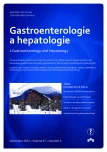Endoscopic resolution of refractory postoperative bile leak from bile duct with fully covered self-expandable metallic stent
Authors:
E. Veseliny 1; J. Radoňak 2; M. Zakuciová 1; M. Janičko 1; P. Jarčuška 1
Authors‘ workplace:
I. interná klinika LF UPJŠ a UN L. Pasteura, Košice
1; I. chirurgická klinika LF UPJŠ a UN L. Pasteura, Košice
2
Published in:
Gastroent Hepatol 2013; 67(6): 468-473
Category:
Digestive Endoscopy: Case Report
Overview
The role of endoscopic therapy in the treatment of bile leaks is well established. Therapeutic endoscopic retrograde cholangiography with biliary sphincterotomy, placement of a transpapillary plastic biliary stent, or a combination of biliary sphincterotomy and stenting has become the first-line intervention in the treatment of a bile leak. For high-grade bile leaks, sphincterotomy alone has been shown to be less effective than transpapillary biliary stenting, and combined biliary sphincterotomy and transpapillary stenting is preferable in such situations. We present a clinical case of a 56-year-old woman with bile leak after open cholecystectomy and choledochotomy for cholecystolithiasis and choledocholithiasis with stenotic distal common bile duct due to chronic calcifying pancreatitis, in whom previous transpapillary insertion of plastic stent was not succesfull, but following temporary transpapillary insertion of fully covered self-expandable metallic biliary stent led to closure of a refractory bile leak.
Key words:
bile leak – biliary fully covered self-expandable metallic stent – endoscopic retrograde cholangiopancreatography – choledochotomy
The authors declare they have no potential conflicts of interest concerning drugs, products, or services used in the study.
Redakční rada potvrzuje, že rukopis práce splnil ICMJE kritéria pro publikace zasílané do biomedicínských časopisů.
The Editorial Board declares that the manuscript met the ICMJE „uniform requirements“ for biomedical papers.
Submitted:
9. 7. 2013
Accepted:
6. 10. 2013
Sources
1. Bridges A,Wilcox CM, Varadarajulu S. Endoscopic management of traumatic bile leaks. Gastrointest Endosc 2007; 65(7): 1081–1085.
2. Sandha GS, Bourke MJ, Haber GB et al. Endoscopic therapy for bile leak based on a new classification: results in 207 patients. Gastrointest Endosc 2004; 60(4): 567–574.
3. Barkun AN, Rezieg M, Mehta SN et al. Postcholecystectomy biliary leaks in the laparoscopic era: risk factors, presentation, and management. McGill Gallstone Treatment Group. Gastrointest Endosc 1997; 45(3): 277–282.
4. Shah JN, Ahmad NA, Shetty K et al. Endoscopic management of biliary complications after adult living donor liver transplantation. Am J Gastroenterol 2004; 99(7): 1291–1295.
5. Bhattacharjya S, Puleston J, Davidson BR et al. Outcome of early endoscopic biliary drainage in the management of bile leaks after hepatic resection. Gastrointest Endosc 2003; 57(4): 526–530.
6. Kaffes AJ, Hourigan L, De Luca N et al. Impact of endoscopic intervention in 100 patients with suspected postcholecystectomy bile leak. Gastrointest Endosc 2005; 61(2): 269–275.
7. Simmons DT, Petersen BT, Gostout CJ et al. Risk of pancreatitis following endoscopically placed large-bore plastic biliary stents with and without biliary sphincterotomy for management of postoperative bile leaks. Surg Endosc 2008; 22(6): 1459–1463.
8. Pfau PR, Kochman ML, Lewis JD et al. Endoscopic management of postoperative biliary complications in orthotopic liver transplantation. Gastrointest Endosc 2000; 52(1): 55–63.
9. Pausawasadi N, Soontornmanokul T, Rerknimitr R. Role of fully covered self--expandable metal stent for treatment of benign biliary strictures and bile leaks. Korean J Radiol 2012; 13 (Suppl 1): S67–S73.
10. Baron TH, Poterucha JJ. Insertion and removal of covered expandable metal stents for closure of complex biliary leaks. Clin Gastroenterol Hepatol 2006; 4(3): 381–386.
11. Kahaleh M, Sundaram V, Condron SL et al. Temporary placement of covered self-expandable metallic stents in patients with biliary leak: midterm evaluation of a pilot study. Gastrointest Endosc 2007; 66(1): 52–59.
12. Wang AY, Ellen K, Berg CL et al. Fully covered self-expandable metallic stents in the management of complex biliary leaks: preliminary data – a case series. Endoscopy 2009; 41(9): 781–786.
13. Canena J, Liberato M, Horta D et al. Short-term stenting using fully covered self-expandable metal stents for treatment of refractory biliary leaks, postsphincterotomy bleeding, and perforations. Surg Endosc 2013; 27(1): 313–324.
14. García-Cano J, Delgado-Torres V, Jimeno-Ayllón C. Initial experience with the new fully covered Wallflex® biliary stent used as a removable endoprosthesis in benign conditions. Endoscopy 2009; 41 (Suppl 1): A395.
15. Luigiano C, Bassi M, Ferrara F et al. Placement of a new fully covered self-expanding metal stent for postoperative biliary strictures and leaks not responding to plastic stenting. Surg Laparosc Endosc Percutan Tech 2013; 23(2): 159–162.
Labels
Paediatric gastroenterology Gastroenterology and hepatology SurgeryArticle was published in
Gastroenterology and Hepatology

2013 Issue 6
Most read in this issue
- Diagnosis of disorders of gastric emptying in diabetic patients with diabetic autonomic neuropathy
- Endoscopic resolution of refractory postoperative bile leak from bile duct with fully covered self-expandable metallic stent
- Guidelines of the Czech gastroenterological society – endoscopic treatment of Barrett´s esophagus and early esophageal neoplasia
- Hepatocellular carcinoma – our experience with surveillance, effect and complications of transarterial chemoembolization
